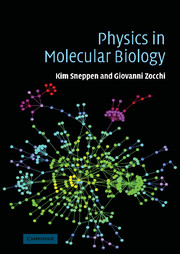Book contents
- Frontmatter
- Contents
- Preface
- Introduction
- 1 What is special about living matter?
- 2 Polymer physics
- 3 DNA and RNA
- 4 Protein structure
- 5 Protein folding
- 6 Protein in action: molecular motors
- 7 Physics of genetic regulation: the λ-phage in E. coli
- 8 Molecular networks
- 9 Evolution
- Appendix Concepts from statistical mechanics and damped dynamics
- Glossary
- Index
5 - Protein folding
Published online by Cambridge University Press: 06 July 2010
- Frontmatter
- Contents
- Preface
- Introduction
- 1 What is special about living matter?
- 2 Polymer physics
- 3 DNA and RNA
- 4 Protein structure
- 5 Protein folding
- 6 Protein in action: molecular motors
- 7 Physics of genetic regulation: the λ-phage in E. coli
- 8 Molecular networks
- 9 Evolution
- Appendix Concepts from statistical mechanics and damped dynamics
- Glossary
- Index
Summary
For a typical protein, the global stability at room temperature is of the order 10 kcal/mol ∼20 kBT for a ∼100 residue domain. Thus proteins are stabilized with a free energy of a fraction of kBT per amino acid. Nonetheless, proteins have well-defined structures that are stabilized by cooperative interactions between their many small parts. Thus there is essentially no “partial melting” of the protein; it stays folded and specifically functional to do whatever job it is supposed to do. When a large enough fluctuation does indeed melt the protein, the structure can (mostly) reassemble.
Themiracle of protein structure and function in the noisy Brownian environment of ongoing kBT perturbations may be envisioned as a car engine exposed to perturbations that could easily tear any part of it at any time. Imagine that a car would melt at maybe 70°C, but would stay together and remain functional nearly all the time. However, should it disassemble, it would reassemble by itself and resume functioning. Proteins may be regarded as “intelligent” and robust nano-technology made of programmable matter.
Proteins can fold into their native state in a remarkably short time; one infers from this that the enormous phase space available to the polypeptide chain must be sampled not randomly, but following one or more “folding pathways”. Thus the amino acid sequence contains not only the plan for the final structure, but it also specifies how to get there (see Fig. 5.1).
- Type
- Chapter
- Information
- Physics in Molecular Biology , pp. 95 - 126Publisher: Cambridge University PressPrint publication year: 2005



